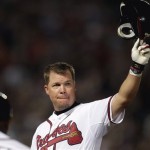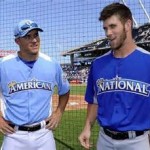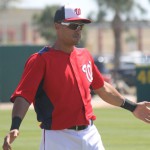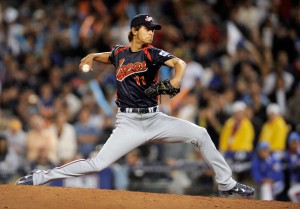I was listening to a podcast this past weekend and the host mentioned something in passing related to Chipper Jones being the last of a dying breed: one-team Hall-of-Famers. In the modern age of free agency, we’re seeing iconic players such as Albert Pujols (and in other sports lately, Paul Pierce and Peyton Manning) switch teams mid-to-end of their careers and sullying their legacy in their original city.
It got me thinking: who in baseball right now are the best remaining chances of guys being single-team Hall of Famers?
Using the Current Baseball-Reference Active career WAR leaders as a guide to finding players (and using Baseball Prospectus’ Cots Salary database to quote contract years), lets take a look. The players are listed in descending order of total career WAR. The first few names are obvious. Then there’s a group of younger guys who have yet to play out their arbitration years and who could easily jump ship and sign elsewhere in free agency; i’ll put in a complete WAG as to the chances of the player staying with one team their entire career.
Hall of Fame Locks and Likelys
1. Derek Jeter, New York Yankees. 100% likelihood he retires as a Yankee, and 100% likelihood of being a first ballot hall of famer.
2. Mariano Rivera, New York Yankees. As with Jeter, he’s 100% to retire as a Yankee (having already announced his retirement) and should be a first ballot hall of famer as inarguably the best late-inning reliever the game has known.
3. Yasiel Puig, Los Angeles Dodgers. Just kidding. Come on, you laughed.
4. Joe Mauer, Minnesota Twins. Its hard to envision someone being more of a franchise player than Mauer; born in Minnesota, High School in Minnesota, 1st overall draft pick by the Minnesota Franchise. Massive contract with full no-trade through 2018. I think Mauer will be a Twin for life. Hall of Fame chances? Looking pretty good; already has an MVP and has a career .323 BA for a catcher, pretty impressive.
5. Robinson Cano, New York Yankees. He’s about half way through his career, but his numbers and accolades keep piling up. Pretty soon we’re going to look up and he’s going to have 400 homers and a career BA above .300 as a 2nd baseman with a slew of top 5 MVP finishes, and we’ll be asking ourselves where Cano ranks in the pantheon of baseball 2nd basemen. Here’s the canonical list of 2nd basemen elected to the hall of fame in the last 50 years: Roberto Alomar, Ryne Sandberg, Rod Carew and Joe Morgan. Do you think Cano belongs there? Now, will Cano stay a Yankee? We’ll soon find out: he’s just played out his two option years and has not been extended. Are the Yankees preparing to let him walk?
6. Justin Verlander, Detroit Tigers. He’s struggled this year as compared to his typical lofty achievements, but he already owns the career trifecta of awards (RoY, MVP, Cy Young). He’s signed through 2019 with a 2020 option, at which point he’ll be 37. He probably won’t get to 300 wins but he could broach 250 with excellent career numbers. Will he stay with Detroit? It seems like a safe bet.
Honorable Mentions: Juston Morneau: early numbers supported it, but he has aged fast. Update 9/1/13 traded away from Minnesota in a waiver-wire deal; no longer eligible.
Borderline Hall of Fame Guys
1. Todd Helton, Colorado Rockies. He turns 40 in August, has played his entire career with Colorado and is in the final year of a two-year deal. His production has vastly tailed off the last two years and I can’t see him playing again after this season. But, we haven’t heard any retirement news either, so I wonder if he’s going to be one of these one-teamers that tries to play one season too long. Chances of Hall-of-Fame: 33%. I think he’s going to have the same issues that Larry Walker is having; despite a career 134 OPS+ his home OPS is nearly 200 points higher than his road OPS, and I think writers will believe him to be an offensive juggernaut borne of Denver.
2. Chase Utley, Philadelphia Phillies. He’s struggled with injuries four seasons running now, but otherwise has great career offensive numbers for a 2nd Baseman. Even if he gets healthy, he may fall short of the Hall of Fame for similar reasons to those of Jeff Kent. And, Utley doesn’t have an MVP. However, Utley may be falling off this list because his name is prominently mentioned in trade-rumors if the Phillies decide to sell.
3. David Wright, New York Mets. He’s in his 10th season with the Mets and is signed through 2020, so his chances of being a career one-teamer seem high. Not 100% though; He’ll be 37 at the end of this deal and may want a couple more seasons; will he be productive enough and stay healthy enough to earn another short-term deal that late in his career? Is he trending towards the Hall of Fame? Probably not; he’s got plenty of All Star appearances, Gold Gloves and Silver Sluggers but relatively little MVP love. In this respect he needs his team to be better.
4. Jimmy Rollins, Philadelphia Phillies. Rollins is the subject of a long, long running joke amongst my close friends. One die-hard Philly fan made his argument that Rollins was a sure-fire Hall of Famer, and the rest of us mocked him for being such a homer. In reality, his Hall of Fame case likely ends up being really debatable. He has a smattering of career accomplishments but not nearly as many as (say Barry Larkin, the most recent elected SS). Now, does Rollines remain in Philadelphia? Probably; he’s signed through 2015, at which point he’ll be 37. I can see Philadelphia keeping him on board with a 2 year deal at that point.
Too Early to tell Guys
1. Felix Hernandez, Seattle Mariners. Signed through 2019 for just absolutely ridiculous money (he’ll make $27M in the year 2019). Of course, he’s just 27 now so he’ll still have some career left by then. Will he stay in Seattle? A good bet. Will he continue to look like a hall-of-famer? Also a good bet, despite his velocity loss. But like any other guy who’s only 27, its hard to project 10-15 years down the road, especially for pitchers.
2. Dustin Pedroia, Boston Red Sox. Pedroia doesn’t seem like a guy who is mentioned in the same breath as hall-of-famers, especially when compared to Cano above. But here’s what Pedroia has that Cano doesn’t: A Rookie of the Year award AND an MVP award. Pedroia has bounced back in 2013 from a couple of injury-plagued years and has put him self back in position to gain MVP votes if Boston makes the post-season. Will he stay in Boston? Seems like hit; he seems like a classic career Red Sox Captain-in-the-making.
3. Ryan Braun, Milwaukee Brewers. Great production, career accolades, signed to a long-term deal for a mid-market team. He has all the makings of being a classic one-team Hall of Famer …. except for the small fact that he’s a) already tested positive for banned substances and b) is becoming public enemy #2 (behind Alex Rodriguez) because of his arrogance in being caught up in the Biogenesis scandal AFTER beating the testing rap. He could win 3 more MVPs and I don’t see him making the hall-of-fame until some veteran’s committee 75 years from now posthumously puts in all these PED cheaters of the 90s and today.
4. Evan Longoria, Tampa Bay Rays. He’s signed with options through 2023. He’s always on the short list of the best third basemen (offensively and defensively) in the majors. He’s already had a series of all-time highlight moments in his career. But from a cumulative accolades stand point, he’s very much lacking. While he won the 2008 Rookie of the Year award, the closest he’s come to an MVP is 6th, and his 2013 All-Star snub means he’s only appeared in the game 3 times. I think he’s going to need a run of healthy, strong seasons to really put his name in the HoF mix.
5. Ryan Zimmerman, Washington Nationals and Troy Tulowitzki with Colorado: both guys are here for the same reasons: they are each team’s “Face of the Franchise” and are likely never going to play anywhere else. They’re both signed to very long term deals. In Zimmerman’s case, he’s a local guy. As for Hall of Fame chances, right now they look very negligible for both players. Not because they’re not good, but because both are too inconsistently injured to put together the full seasons needed to stay in the minds of all-star and MVP voters. They are what Longoria is heading towards: injury plagued solid players who are the cornerstone of their teams for a 15 year stretch.
6. Joey Votto, Cincinnati Reds. Here’s a fun fact: Votto trails our own Ryan Zimmerman in career war despite being a year older. He’s signed with Cincinnati with options through 2024, at which point he’ll be 41, so he’s almost guaranteed to be a one-team guy. Will he accumulate enough accomplishments to be a Hall of Famer? So far so good. He’s one of the most feared hitters in the league and seems to be getting better.
7. Matt Cain, Cole Hamels, Jered Weaver: all three of these guys have nearly identical career WARs, all are signed for relatively long-term deals, all are on most people’s shorter lists of the best starters in the game, and all are between 28-30 right now. But ironically, I don’t see any of them as hall-of-famer calibre talent when compared to the next small jump up in talent in the league right now (see the next player).
8. Clayton Kershaw, Los Angeles Dodgers. It is foolish to speculate on the Hall of Fame chances of a 25 year old pitcher. But Kershaw seems to be a safe bet to sign the largest pitcher contract in history with the nouveaux-rich Dodger’s ownership group, so he could continue to pitch in the cavern of Dodger stadium for another 10 years and start to really approach some hall-of-fame mandate numbers. Ask yourself this; who would you rather have for the next 10 years, Kershaw or Stephen Strasburg?
Summary: In all of baseball, just two HoF one-team locks. A couple more good bets for being career one-teamers but by no means HoF locks. So yeah, it seems like the one-team hall-of-famer is going the way of the Reserve Clause.



